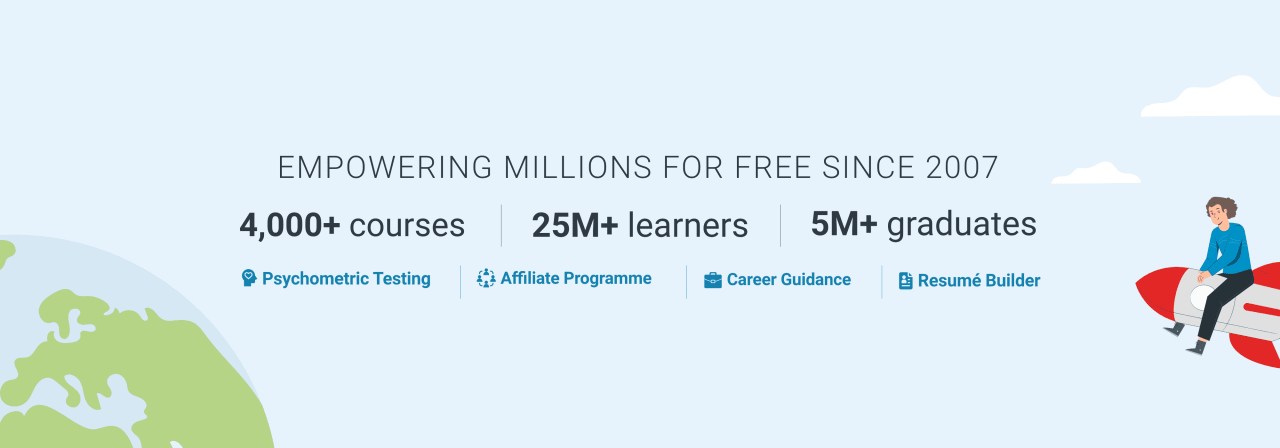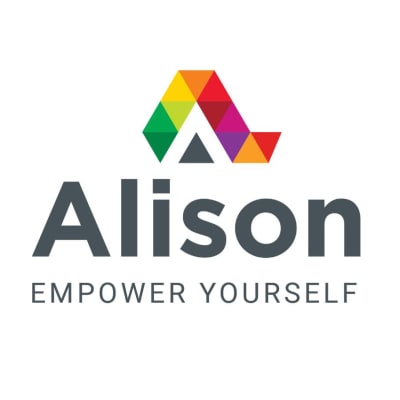
Human Anatomy and Physiology (Free Online Course With Diploma)
Alison Free Online Learning

Key Information
Campus location
Online
Languages
English
Study format
Distance Learning
Duration
10 - 15 hours
Pace
Full time, Part time
Tuition fees
Request info
Application deadline
Request info
Earliest start date
Request info
* free course
Scholarships
Explore scholarship opportunities to help fund your studies
Introduction
This course covers human anatomy and lays out the physiology of the cardiovascular, respiratory, reproductive, skeletal and nervous systems, among others. We explore the amazing inner workings of the body, which is a complex collection of interacting systems that carry out the important functions that let you move, think, feel and live. This course suits anyone interested in studying medicine or who simply wants to understand how bodies work.
This Free Online Course Includes:
- 10-15 Hours of Learning
- CPD Accreditation
- Final Assessment
Alison Certificates
All Alison courses are free to enrol study and complete. To successfully complete this Diploma course and become an Alison Graduate, you need to achieve 80% or higher in each course assessment. Once you have completed this Diploma course, you have the option to acquire an official Diploma, which is a great way to share your achievement with the world.
Your Alison Diploma is:
- Ideal for sharing with potential employers
- Include it in your CV, professional social media profiles and job applications.
- An indication of your commitment to continuously learn, upskill & achieve high results.
- An incentive for you to continue empowering yourself through lifelong learning.
Alison offers 3 types of Diplomas for completed Diploma courses:
- Digital Diploma: a downloadable Diploma in PDF format immediately available to you when you complete your purchase.
- Diploma: a physical version of your officially branded and security-marked Diploma, posted to you with free shipping.
- Framed Diploma: a physical version of your officially branded and security-marked Diploma in a stylish frame, posted to you with free shipping.
Gallery
Scholarships and Funding
Curriculum
Have you ever wondered why you react quickly when you touch a hot surface? This is because the nervous system transmits neural impulses to the brain, which in turn sends a message to your muscles. This intriguing course uses detailed diagrams to explore the anatomical features and physiological functions of each important bodily system. This helps you to easily learn how these systems develop and interact with each other.
We examine the structure and functions of blood and blood vessels, the heart, the digestive system, the muscular system, the respiratory system, the nervous system and the skeleton. The course also covers the structure and functions of the reproductive systems and traces the development of offspring during the intrauterine process (gestation).
This course is ideal for aspiring medical students who need to learn about biomedical science and also those who just want to expand their knowledge and understanding of the human body and its organs. Sign up to improve your understanding of the body.
Module 1
Introduction to the Cardiovascular System
In this module, you will be introduced to the circulatory systems and cardiovascular systems. You will also be introduced to the functions and components of blood.
Module 2
The Blood Vessels and the Heart
In this module, you will be introduced to the types, functions and structures of blood vessels. Furthermore, you will be introduced to the parts of the heart and cardiac system as well as the functions they serve. Additionally, you will learn about the connection between the blood vessel system and the heart.
Module 3
Introduction to the Human Digestive System
In this module, you will be introduced to the human digestive system. This will include information on how energy is obtained from food, the main food types, and the digestive process. The structure and functions of the stomach will also be described.
Module 4
Digestion, Absorption, Elimination and Protection
In this module, you will be introduced to the methods in which food is digested, how nutrients are absorbed, the elimination of waste materials, and the protective mechanisms of the digestive system. Furthermore, this module will briefly describe the function of mammary glands in protecting babies from infection during breastfeeding.
Module 5
Diploma in Human Anatomy and Physiology - Revised: First Assessment
This Course Assessment will now enable you to review your learning so you can determine your knowledge and understanding of the following areas: HUMAN CARDIOVASCULAR SYSTEM HUMAN DIGESTIVE SYSTEM Remember, if you do not achieve the required standard after the first attempt, you can re-take the assessment until a successful outcome is achieved.
Module 6
Introduction to the Respiratory System
In this module, you will be introduced to the respiratory system. This module will describe why the human respiratory system is necessary, the difference between breathing and respiration, and the structure of the human trunk.
Module 7
Organs in the Respiratory System
In this module, you will be introduced to the various organs in the respiratory system. You will also learn how human speech is produced and the functions of respiratory organs. Also, you will learn the difference between nutrient and functional blood, and how gases are transported around the body.
Module 8
Introduction to the Reproductive System
In this module, you will be introduced to the human reproductive system. This will include the identification of the different sex hormones, genitalia, and the process of fertilization. Furthermore, you will learn the structure and function of both the male and female reproduction systems. Lastly, aspects of fertilization, pregnancy, and childbirth are described.
Module 9
Introduction to the Urinary System
Module 10
Sense of Vision
In this module, you will learn why the human body needs senses, the difference between general and special senses, and the structure and functions of the eye.
Module 11
The Senses of Hearing, Balance, Smell and Taste
In this module, you will be introduced to the nervous pathways for hearing, as well as the structure and function of the ears. Furthermore, the process of "general body sense" will be described. Lastly, this module will identify the sensory receptors and the olfactory sensory receptors for taste and smell.
Module 12
Diploma in Human Anatomy and Physiology - Revised: Second Assessment
This Course Assessment will now enable you to review your learning so you can determine your knowledge and understanding of the following areas: Human Respiratory System, Human Reproduction System, Human Urinary System, and Human Sensory Organs, if you do not achieve the required standard after the first attempt, you can re-take the assessment until a successful outcome is achieved.
Module 13
Introduction to the Human Skeletal System
In this module, you will be introduced to the functions and types of bones found in the human skeleton. Furthermore, you will learn about the tissue types and processes found in skeletal elements. Lastly, you will learn the differences between the axial and appendicular skeletons.
Module 14
Human Skeletal System -- Bones and Joints
In this module, you will be introduced to the differences between long and flat bones. You will also learn the steps involved in bone development. Furthermore, you will learn the conditions of the cranium and sesamoid bones. Lastly, you will learn about the types of joints and elements of particular joints.
Module 15
Introduction to the Human Nervous System
In this module, you will be introduced to the human nervous system. You will be introduced to the structural and functional organization of the human nervous system. Furthermore, you will be introduced to the structure of the brain, spinal nerves, and the difference between the peripheral and autonomic nervous systems.
Module 16
The Transmission of Neural Impulses
In this module, you will be introduced to the electrochemical transmission of neuron impulses in the human nervous system. You will also be introduced to the difference between the synapse and the neuromuscular junction. Furthermore, you will learn about pathways in the human nervous system, such as a general sensory path and a motor pathway.
Module 17
Introduction to Muscle Tissues
In this module, you will learn why there is a need for a human muscular system as well as the different types of muscles. Furthermore, you will learn about fatigue and how it relates to muscles.
Module 18
Introduction to the Mechanics and Nervous Control of Skeletal Muscles
In this module, you will be introduced to the different skeletomuscular mechanics. You will be introduced to the structure of the skeletomuscular unit, the roles of skeletal muscles, and the ways the exercise affects skeletal muscles. Furthermore, you will learn about the nervous control of skeletal muscles.
Module 19
Diploma in Human Anatomy and Physiology - Revised: Third Assessment
This Course Assessment will now enable you to review your learning so you can determine your knowledge and understanding of the following areas: Human Skeletal System, Human Nervous System, and Human Muscular System. Remember, if you do not achieve the required standard after the first attempt, you can re-take the assessment until a successful outcome is achieved.
Module 20
Course assessment
Program Outcome
What You Will Learn In This Free Course
- Describe the structure and functions of blood and blood vessels, the heart, the digestive system, the muscular system and the nervous system.
- Explain the transmission of neural impulses.
- Lay out the workings of the male and female reproductive systems.
- Trace the development of offspring during the intrauterine process.
- Outline the structure and functions of the respiratory system, sensory organs and skeleton.
Complete This CPD Accredited Course & Get Your Diploma!
Certify Your Skills
A CPD-accredited Alison Diploma/Certificate certifies the skills you’ve learned.
Stand Out From The Crowd
Add your Alison Certification to your resume and stay ahead of the competition.
Advance in Your Career
Share your Alison Certification with potential employers to show off your skills and capabilities.
Career Opportunities
Gynecological Laparoscopic Surgeon
A Gynecological Laparoscopic Surgeon combines general surgical skills, low-risk minimally invasive laparoscopic techniques, and specialized knowledge of women’s health to bring relief to their patients.
Cardiologist
Their words inspire hope and their actions save lives. Cardiologists make your heartbeat match the beat of the universe by diagnosing, treating and preventing diseases that mainly affect the heart and blood vessels.
General Physician
Being a General Physician offers the most complete and constant union of those three qualities which have the most exceptional charm for pure and active minds – novelty, utility, and charity. General Physicians dispense not only medicines but words that influence the patient more than the medication.